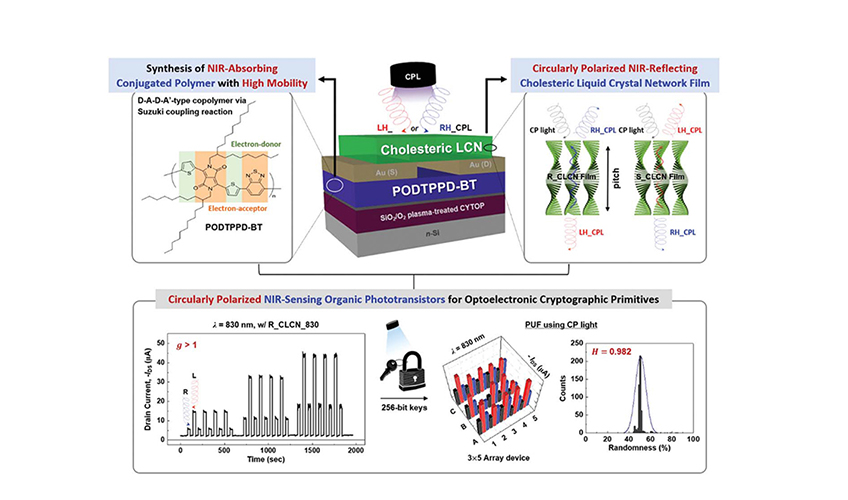- 작성일
- 2021.05.24
- 수정일
- 2021.05.24
- 작성자
- 김성애
- 조회수
- 205
[PNU리서치] 안석균 교수팀, SW 해킹 차단 기술 개발(20-10-22)
빛의 회전 특성 이용한 근적외선 광트랜지스터 개발…고성능·저비용 암호화 소자로 보안성능 강화 기대

스마트폰과 가전·드론·무인자동차 등이 실시간으로 데이터를 주고받는 사물인터넷(IoT) 기술은 이용자와 자산의 안전에 직결되는 만큼 강력한 보안 솔루션이 필요하다. 이에 따라 해킹에 노출되기 쉬운 소프트웨어 기반의 키 방식을 보완할 ‘물리적 복제 방지 기능(Physical Unclonable Function, PUF)’이 주목받고 있다.
하드웨어 기반의 PUF 반도체 칩은 인간의 홍채나 지문처럼 고유의 물리적 코드를 갖고 있다. 제조공정에서 생성되는 미세구조의 편차를 키 값으로 갖기 때문에 PUF로 생성되는 보안 키는 랜덤하게 생성돼 고유성을 지니며 복제가 불가능하다. 하지만 더 높은 수준의 안전성을 위해 키가 생성되는 조합의 수를 늘리려면 하드웨어의 구조도 바꿔야 하는 한계가 노출된 바 있다.

<이번 연구의 교신저자인 고분자공학과 안석균(왼쪽) 교수와 제1저자 이유진 학생>
이런 가운데, 고분자공학과 안석균 교수팀이 한국과학기술연구원(KIST) 광전소재연구단 임정아·주현수 박사팀과 공동연구를 통해 하드웨어 구조 변경 없이도 빛의 회전(편광) 특성을 이용해 PUF의 보안성능을 크게 강화할 수 있는 암호화 소자를 개발했다.
특히, 연구진은 나선형으로 나아가는 빛인 원편광을 암호화에 활용했다. 이를 위해 회전 방향에 따라 소자에 도달하는 빛의 양이 조절되는 콜레스테릭 액정 고분자 필름을 근적외선을 감지하는 유기 광트랜지스터(Phototransistor, 전류·전압과 함께 파장·강도 등 빛의 기본 특성을 감지해 신호 증폭 스위치 역할을 하는 소자)에 결합했다.
이렇게 두 가지 소재가 결합된 광트랜지스터는 액정 나선구조의 방향과 같은 방향으로 회전하는 빛은 반사시키고, 반대 방향의 빛은 투과시킴으로써 빛의 회전 방향을 구분해서 감지할 수 있다. 그 결과, 소자의 물리적 크기를 바꾸지 않고도 암호화 키 생성에 사용되는 조합의 수를 증가시켜 해킹과 도·감청 등을 원천 차단할 수 있는 PUF 소자를 제작하는 데 성공했다.
연구팀이 개발한 소자는 기존의 나노패터닝 기반 근적외선 원편광 감응 광트랜지스터보다 최소 30배 이상 우수한 고감도를 보였으며, 가시광선 원편광만을 감지할 수 있던 기존의 유기 광트랜지스터 소자들과는 달리, 근적외선 영역의 원편광을 감지할 수 있어 광통신·양자컴퓨팅 등의 차세대 광전소자에 널리 적용될 수 있을 것으로 기대된다.
안석균 교수는 “이번 결과는 콜레스테릭 액정 고분자 고유의 카이랄 성을 암호화 보안기술에 접목시킨 최초의 연구성과로 액정 고분자의 새로운 응용분야를 제시하였다는 점에서 중요한 의미가 있다”고 말했다.
이번 연구는 과학기술정보통신부 지원 아래 KIST 주요사업 및 한국연구재단 전략과제, 개인기초과제 및 소재융합혁신기술개발사업으로 수행됐으며, 소재 분야의 국제학술지
『Advanced Functional Materials』 9월 22일자 온라인판에 게재됐다(논문명: High-Performance Circularly Polarized Light-Sensing Near-Infrared Organic Phototransistors for Optoelectronic Cryptographic Primitives). 이번 연구에는 고분자공학과 안석균 교수팀 외에 전자공학과 윤태훈 교수와 최연규 연구원이 공동으로 참여했다.
한편, 제1저자로 참여한 이유진 Texas A&M 대학교 박사과정생(올해 2월 부산대 고분자공학과 학부 졸업)은 이번 연구에서 핵심적인 역할을 함으로써 당시 학부연구생임에도 불구하고 최상위급 SCI 저널에 공동 제1저자로 논문을 발표하는 우수한 성과를 올렸다.
* 논문 바로 보기 https://onlinelibrary.wiley.com/doi/10.1002/adfm.202006236
* 사진(상단): 근적외선 원편광 감응 광트랜지스터 개발의 주요 전략에 관한 모식도
근적외선 감응 고이동도의 공액고분자 합성 및 근적외선 원편광 반사 콜레스테릭 액정 네트워크 필름 제조(위), 근적외선 원편광 감응 광트랜지스터 어레이의 광감응 특성 및 원편광 빛을 사용하는 광전자 암호화 소자로의 응용결과를 보여주는 그림(아래).
PODTPPD-BT : 본 연구에서 합성하여 사용한 고분자반도체, poly[{2,5-bis-(2-octyldodecyl)-3,6-bis-(thien-2-yl)-pyrrolo[3,4-c]pyrrole-1,4-diyl}-co-{2,2’-(2,1,3-benzothiadiazole)-5,5’-diyl}]
CLCN : 본 연구에서 사용한 카이랄 액정 필름, cholesteric liquid crystal network LH_ or RH_CPL : 좌/우원편광, left-handed or right-handed circularly polarized light
PUF : 본 연구에서 사용한 물리적 복제 방지 기능, physical unclonable function
[Abstract]
A strong security technology is essential for Internet of Things (IoT) technology where smart phones, home appliances, drones, and autonomous vehicles exchange data. In this regard, a new security technology called "Physical Unclonable Function (PUF)" has received a great attention because it can complement a conventional software-based key method that can be exposed to hacking. Although hardware-based PUF semiconductor chips have their own physical code like human iris or fingerprints, for higher level of security, the complex microstructure of hardware is required to increase the combination number of keys.
To address this challenge, a research team of Dr. Jung Ah Lim (KIST), Dr. Hyunsu Ju (KIST) and Prof. Suk-kyun Ahn (PNU, Polymer Science and Engineering) developed an encryption device that can significantly enhance the security performance of PUFs by harnessing the characteristics of circularly polarized (CP) light without changing the hardware structure. Specifically, the device incorporates a near-IR (NIR) reflective cholesteric liquid crystal polymer film which can distinguish the direction of CP light into the organic phototransistor (OPTR) based on the small-bandgap conjugated polymer. As a proof-of-concept, the NIR-OPTR device was fabricated into a 3 x 5 array to construct a PUF device, which shown to be highly effective to increase the number of combinations used to generate encryption keys without changing its physical structure. Unlike previous organic phototransistors, which could only detect CP light in the visible wavelength, the phototransistor developed by the research team can have broader range of applications because of its 30 times higher sensitivity as well as the ability to detect NIR light which is commonly used in optical communication and quantum computing.
This study was published in the latest issue of Advanced Functional Materials (IF = 16.836, the top 4.678% in the JCR field) under support of National Research Foundation (NRF) of Korea, Ministry of Science and ICT (MSIT).
* (Title) High-Performance Circularly Polarized Light-Sensing Near-Infrared Organic Phototransistors for Optoelectronic Cryptographic Primitives
- (Co-first author) Korea Institute of Science and Technology, Dr. Hyemi Han
- (Co-first author) Pusan National University, Yoo Jin Lee
- (Co-corresponding author) Korea Institute of Science and Technology, Dr. Jung Ah Lim
- (Co-corresponding author) Korea Institute of Science and Technology, Dr. Hyunsu Ju
- (Co-corresponding author) Pusan National University, Prof. Suk-kyun Ahn
* Figure. High-Performance Circularly Polarized Light-Sensing Near-Infrared Organic Phototransistors for Optoelectronic Cryptographic Primitives
Development of NIR circularly polarized lightsensing thinfilm organic phototransistors (NIR CPLOPTRs). An overall concept for the NIR CPLOPTRs is demonstrated in the present work, including the synthesis of an NIRabsorbing smallbandgap πconjugated polymer (PODTPPDBT) and NIRreflecting cholesteric liquid crystal network (CLCN) films and a demonstration of their application to the NIR CPLOPTR array devices as well as optoelectronic cryptographic primitives using CP light.
(2020.10.23.)
- 첨부파일
- 첨부파일이(가) 없습니다.